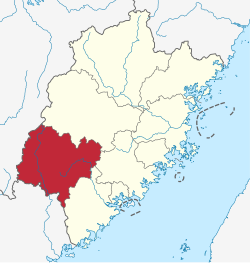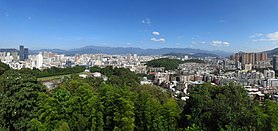Longyan(simplified Chinese:Long nham;traditional Chinese:Long nham;pinyin:ⓘ;Pe̍h-ōe-jī:Lêng-nâ or Liong-nâ;lit.'dragon rock';Hakka:Liùng-ngàm;Longyan dialect:Liông-nâ [liɔŋ˩nã˩]) is aprefecture-level cityin south-westernFujian Province,China, borderingGuangdongto the south andJiangxito the west.
Longyan
Long nham thị Lungyen | |
|---|---|
Clockwise from top:Longyan City,Chuxi tulou clusterinYongding District,the ancient city walls inChangting County,Zhangdi village, and a night view from inside atulou. | |
 | |
 | |
| Coordinates (Longyan municipal government):25°04′34″N117°01′01″E/ 25.076°N 117.017°E | |
| Country | China |
| Province | Fujian |
| Municipal seat | Xinluo |
| Area | |
| 19,069 km2(7,363 sq mi) | |
| Population (2020) | |
| 2,723,627 | |
| • Density | 140/km2(370/sq mi) |
| •Urban | 1,712,623 |
| GDP[2] | |
| •Prefecture-level city | CN¥287 billion US$41.6 billion |
| • Per capita | CN¥ 105,548 US$ 16,575 |
| Time zone | UTC+08:00(CST) |
| Postal code | 364000, 366000 |
| Area code | 597 |
| ISO 3166 code | CN-FJ-08 |
| License plate | Mân F |
| Administrative division code | 350800 |
| Local dialect | Longyan MinandHakka Chinese |
| Website | Longyan.gov.cn |
History
editIn 736 AD (during theTang dynasty), theprefectureofTingzhouwas established in western Fujian, orMinxi(Mân tây), administeringChangting,HuanglianandXinluocounties. Six years later Xinluo was named Longyan for the nearby cavern, a famous scenic site.[3]
Due to the ancient conflicts in centralChinaand aggression from northern tribes, many Han people moved from central China to Longyan.
in 1734, the Hokkien-speaking counties of Longyan city and Zhangping were ceded fromZhangzhouto form the Longyan Prefecture within the Hakka peasant Tingzhou prefecture, a typical Hakka peasant society culturally distinct from the Minnanese by the imperial court. In 1913, it reverted to its former name Longyan County and in 1981, Longyan City was established.
Minxi was a strategic base during theChinese Civil War.
It is said[by whom?]that tens of thousands of people were recruited from the Hakka peasantry from the western Longyan to join the PLA during the Chinese Civil War, and nearly every Hakka family had someone sacrificed lives on behalf of CCP side especially during Mao's early purges in Tingzhou and Ganzhou which killed roughly 700,0000 Hakka people and some ethnic minorities. There are more than 26,000 locals that took part in the Long March which in total was carried out by 86,000. Moreover, during 1955 and 1968, 68 people from Longyan were awarded Brigadier General or above, which accounts for 82% of all generals from Fujian province at the time, therefore, Longyan is also named as "The Home of Generals".[citation needed]
Environment
editUnlike many Chinese cities, the forest coverage of Longyan reaches an unusually high 77.9%, which is unparalleled in Fujian province.[4]Meihuashan National Nature Reserve,a part of theChina Biosphere Reserve Network,is located in Longyan.
GobyRhinogobius longyanensiswas first described from Longyan and named after it.[5]Presumably also the prehistoric bivalveClaraialongyanensisgot its name from Longyan.[6]
Geography and climate
editLongyan is situated in the upper reaches of theJiulongandTingRivers. It borders the prefecture-level cities ofSanmingto the north,Quanzhouto the east,Zhangzhouto the southeast,Meizhou(Guangdong) to the southwest, andGanzhou(Jiangxi) to the west and northwest.[7]
Longyan has amonsoon-influencedhumid subtropical climate(Köppen climate classificationCfa), with short, mild winters, and long, hot and humid summers. Despite its inland location, the city's summers rank among the mildest in the province, averaging lower than evenXiamenand the islands ofPingtan County,both of which receive significant maritime moderation.[8]Rainfall is greatest in spring and early summer and at its least in autumn and early winter.
| Climate data for Longyan, elevation 376 m (1,234 ft), (1991–2020 normals, extremes 1971–2010) | |||||||||||||
|---|---|---|---|---|---|---|---|---|---|---|---|---|---|
| Month | Jan | Feb | Mar | Apr | May | Jun | Jul | Aug | Sep | Oct | Nov | Dec | Year |
| Record high °C (°F) | 28.1 (82.6) |
29.8 (85.6) |
31.5 (88.7) |
33.9 (93.0) |
35.0 (95.0) |
37.5 (99.5) |
39.0 (102.2) |
37.1 (98.8) |
36.6 (97.9) |
35.2 (95.4) |
34.6 (94.3) |
28.1 (82.6) |
39.0 (102.2) |
| Mean daily maximum °C (°F) | 17.9 (64.2) |
19.2 (66.6) |
21.5 (70.7) |
25.6 (78.1) |
28.7 (83.7) |
30.8 (87.4) |
33.2 (91.8) |
32.8 (91.0) |
31.2 (88.2) |
27.9 (82.2) |
23.9 (75.0) |
19.3 (66.7) |
26.0 (78.8) |
| Daily mean °C (°F) | 12.2 (54.0) |
13.8 (56.8) |
16.4 (61.5) |
20.5 (68.9) |
23.7 (74.7) |
26.0 (78.8) |
27.4 (81.3) |
26.9 (80.4) |
25.5 (77.9) |
22.1 (71.8) |
18.0 (64.4) |
13.2 (55.8) |
20.5 (68.9) |
| Mean daily minimum °C (°F) | 8.4 (47.1) |
10.3 (50.5) |
13.0 (55.4) |
16.9 (62.4) |
20.2 (68.4) |
22.8 (73.0) |
23.6 (74.5) |
23.3 (73.9) |
21.8 (71.2) |
17.9 (64.2) |
13.8 (56.8) |
9.3 (48.7) |
16.8 (62.2) |
| Record low °C (°F) | −1.9 (28.6) |
−0.8 (30.6) |
−0.9 (30.4) |
5.6 (42.1) |
12.1 (53.8) |
15.4 (59.7) |
19.4 (66.9) |
17.7 (63.9) |
13.8 (56.8) |
6.0 (42.8) |
1.4 (34.5) |
−3.0 (26.6) |
−3.0 (26.6) |
| Averageprecipitationmm (inches) | 68.5 (2.70) |
95.6 (3.76) |
177.4 (6.98) |
190.6 (7.50) |
260.4 (10.25) |
331.0 (13.03) |
179.2 (7.06) |
235.7 (9.28) |
134.2 (5.28) |
46.8 (1.84) |
45.3 (1.78) |
48.0 (1.89) |
1,812.7 (71.35) |
| Average precipitation days(≥ 0.1 mm) | 8.9 | 11.9 | 17.2 | 16.6 | 18.0 | 19.4 | 15.5 | 17.6 | 12.0 | 5.7 | 6.2 | 7.1 | 156.1 |
| Average snowy days | 0.2 | 0 | 0 | 0 | 0 | 0 | 0 | 0 | 0 | 0 | 0 | 0 | 0.2 |
| Averagerelative humidity(%) | 72 | 75 | 77 | 77 | 77 | 79 | 75 | 78 | 75 | 70 | 70 | 71 | 75 |
| Mean monthlysunshine hours | 122.5 | 98.0 | 92.3 | 107.5 | 118.7 | 129.7 | 202.5 | 184.2 | 170.0 | 176.6 | 156.6 | 145.3 | 1,703.9 |
| Percentpossible sunshine | 37 | 31 | 25 | 28 | 29 | 32 | 49 | 46 | 47 | 50 | 48 | 44 | 39 |
| Source 1:China Meteorological Administration[9][10] | |||||||||||||
| Source 2: Weather China[8] | |||||||||||||
Demographics
editThe prefecture-level city of Longyan had a population of 2,559,545 inhabitants as of 2010, according to the2010 National Census.[11]The population of Longyan in 2010 was 4.65% inferior than in 2000 (when the inhabitants of the city stand at 2,684,310), giving an average annual rate of growth of -0.47%.[11]
Administration
editThe municipal executive, legislature, andjudiciaryare inXinluo District(Tân la khu), together with theCPCandPublic Security Bureau.[12]The information about population uses the 2010 Census data.
| Map | ||||||
|---|---|---|---|---|---|---|
| English name | Simplified | Pinyin | Hakka | Area | Population | Density |
| Xinluo District | Tân la khu | Xīnluó Qū | Sîn-lò-khî | 2,685 | 662,429 | 247 |
| Yongding District | Vĩnh định khu | Yǒngdìng Qū | Yún-thin-khî | 2,216 | 362,658 | 164 |
| Zhangping City | Chương bình thị | Zhāngpíng Shì | Chông-phìn-sṳ | 2,975 | 240,194 | 81 |
| Changting County | Trường đinh huyện | Chángtīng Xiàn | Tshòng-tin-yen | 3,099 | 393,390 | 127 |
| Liancheng County | Liên thành huyện | Liánchéng Xiàn | Lièn-sàng-yen | 2,596 | 248,645 | 96 |
| Shanghang County | Thượng hàng huyện | Shàngháng Xiàn | Sông-hông-yen | 2,879 | 374,047 | 130 |
| Wuping County | Võ bình huyện | Wǔpíng Xiàn | Vú-phìn-yen | 2,630 | 278,182 | 106 |
Culture
editLongyan is inhabited by Hoklo people and Hakka peasants. TheHoklo peoplelive in the urban areas and cities of Xinluo and Zhangping districts in the eastern Longyan prefecture and speakLongyan Minwhile Hakka peasants live in rural village areas of the countryside of the western part of the prefecture, making western Longyan famous for being named as the "Home of Hakka People".[4]The rural county ofChangtingis often referred to as the home of the Hakka, while the Ting River is known as the "mother river" of the Hakka people.
Longyan is a recent artificial construct of the Chinese government, having never been united together before the creation of Modern China. The two culturally distinct and separate Hoklo eastern city areas and Hakka western rural peasant areas have almost nothing in common in terms of language, culture and living habits, and were only forcibly merged into a single administrative region recently in history by the communist government.
Economy
editLongyan serves as a strategic center for the distribution of goods toXiamen,QuanzhouandZhangzhou.It also acts as a gateway for trade withGuangdongandJiangxiprovince. It is the main connection between the inland and coastal area.
Longyan is rich in natural resources such as important mineral deposits and forest zones. TheSeptwolvestobacco business is an important contributor to the local economy, as is theZijin Mininggroup. The largest construction equipment makerLonking Holdingsis based in the city.
Transport
edit- Liancheng Guanzhaishan Airport
- The main railway station isLongyan railway station,which is a junction between theLongyan-Xiamen Railway(high-speed line opened in 2012),Ganzhou–Longyan Railway,andZhangping–Longchuan railway.
- China National Highway 319
- G76 Xiamen–Chengdu Expressway
Notable people from Longyan
edit- Zheng Xiaoying(b. 1929), the very first woman conductor inChina.
- Chen Hong(b. 1979), number 1badmintonplayer on the world-ranking list from 2002 to 2003.
- Deng Zihui(1896–1972), former Chinese vice premier (1951–1965), one of the top leaders of the Chinese Communist Party.
- Huang Kunming(b. 1956), member of the 19th Politburo of China Communist Party.
- Lin Dan(b. 1983), gold medalist at the 2012 and 2008 Summer Olympics, top-rankedbadmintonplayer on the world ranking list from 2004 to 2008.
- Ong Schan Tchow(1900–1945), artist whose exhibitions in China and South-eastern Asia raised funds for the war relief effort and civilian victims of theSecond Sino-Japanese War
- Shi Zhiyong(b. 1980), weightlifter, gold medalist at the2004 Summer Olympics.
- Yang Chengwu(1914–2004), general of thePeople's Liberation Army.
- Zeng Jinyan(b. 1983),bloggerand human rights activist.
- Zhang Dingcheng(1898 – December 16, 1981), Procurator-General of theSupreme People's Procuratoratefrom 1954 to 1975.[13]
- Zhang Xiangxiang(b. 1983), weightlifter, gold medalist at the2008 Summer Olympicsand bronze medalist at the2000 Summer Olympics.
- Zhang Yiming(b. 1983), Internet entrepreneur, founder ofByteDance,second-richest person inChina.
- Lin Shen(b. 1980), actor, born inBeijingwith ancestral roots in Longyan.
- Wang Xing(b. 1979), Internet entrepreneur, founder ofMeituan-Dianping.
See also
editReferences
edit- ^2008 niên hành chính khu hoa(in Simplified Chinese). Longyan Municipal Statistic Bureau. 2009-06-05.Retrieved2009-12-08.
- ^Phúc kiến tỉnh thống kế cục, quốc gia thống kế cục phúc kiến điều tra tổng đội (August 2021).《 phúc kiến thống kế niên giám -2021》.China Statistics Press.ISBN978-7-5037-9510-7.Archived fromthe originalon 2022-03-01.Retrieved2021-12-23.
- ^Longyan GoverNment."Longyan History".Longyan Government.
- ^abThị tình đặc điểm.Longyan People's Government.
- ^Froese, Rainer;Pauly, Daniel (eds.)."Rhinogobius longyanensis".FishBase.August 2013 version.
- ^"†Claraia longyanensisChen 1976 (clam) ".Paleobiology Database.Retrieved20 October2013.
- ^Longyan GoverNment."Natural Geography".Longyan Government.
- ^abLong nham thành thị giới thiệu.Weather China(in Chinese (China)).
- ^Trung quốc khí tượng sổ cư võng – WeatherBk Data(in Simplified Chinese).China Meteorological Administration.Retrieved23 June2023.
- ^ Trung quốc khí tượng sổ cư võng(in Simplified Chinese).China Meteorological Administration.Retrieved23 June2023.
- ^ab(in Chinese)Longyan Statistic Bureau.Data from the Sixth National Population Census of the People's Republic of China
- ^Longyan Government."Administrative Division".Longyan Government.
- ^"Wilson Center Digital Archive".digitalarchive.wilsoncenter.org.Retrieved2021-05-31.






